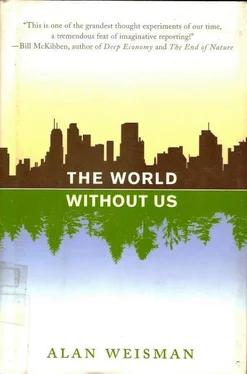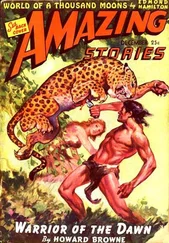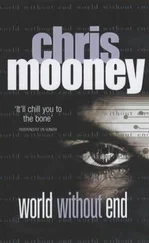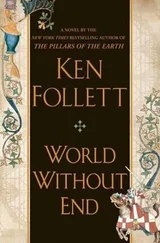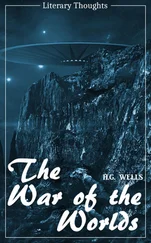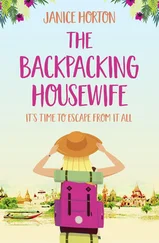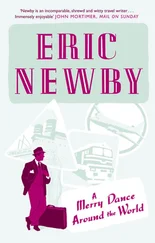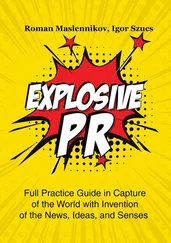Many foreign ornamentals—double roses, for example—will wither with the civilization that introduced them, because they are sterile hybrids that must propagate through cuttings. When the gardeners that clone them go, so do they. Other pampered colonials like English ivy, left to fend for themselves, lose to their rough American cousins, Virginia creeper and poison ivy.
Still others are really mutations, forced by highly selective breeding. If they survive at all, their form and presence will be diminished. Untended fruits such as apples—an import from Russia and Kazakhstan, belying the American Johnny Appleseed myth—select for hardiness, not appearance or taste, and turn gnarly. Except for a few survivors, unsprayed apple orchards, defenseless against their native American scourges, apple maggots and leaf miner blight, will be reclaimed by native hardwoods. Introduced garden plot vegetables will revert to their humble beginnings. Sweet carrots, originally Asian, quickly devolve to wild, unpalatable Queen Anne’s lace as animals devour the last of the tasty orange ones we planted, says New York Botanical Garden vice president Dennis Stevenson. Broccoli, cabbage, Brussel sprouts, and cauliflower regress to the same unrecognizable broccoli ancestor. Descendants of seed corn planted by Dominicans in Washington Heights parkway medians may eventually retrace their DNA back to the original Mexican teosinte, its cob barely bigger than a sprig of wheat.
The other invasion that has accosted natives—metals such as lead, mercury, and cadmium—will not wash quickly from the soil, because these are literally heavy molecules. One thing is certain: when cars have stopped for good, and factories go dark and stay that way, no more such metals will be deposited. For the first 100 years or so, however, corrosion will periodically set off time bombs left in petroleum tanks, chemical and power plants, and hundreds of dry cleaners. Gradually, bacteria will feed on residues of fuel, laundry solvents, and lubricants, reducing them to more-benign organic hydrocarbons—although a whole spectrum of man-made novelties, ranging from certain pesticides to plasticizers to insulators, will linger for many millennia until microbes evolve to process them.
Yet with each new acid-free rainfall, trees that still endure will have fewer contaminants to resist as chemicals are gradually flushed from the system. Over centuries, vegetation will take up decreasing levels of heavy metals, and will recycle, redeposit, and dilute them further. As plants die, decay, and lay down more soil cover, the industrial toxins will be buried deeper, and each succeeding crop of native seedlings will do better.
And although many of New York’s heirloom trees are endangered if not actually dying, few if any are already extinct. Even the deeply mourned American chestnut, devastated everywhere after a fungal blight entered New York around 1900 in a shipment of Asian nursery plants, still hangs on in the New York Botanical Garden’s old forest—literally by its roots. It sprouts, sends up skinny shoots two feet high, gets knocked back by blight, and does it again. One day, perhaps, with no human stresses sapping its vigor, a resistant strain will finally emerge. Once the tallest hardwood in American eastern forests, the resurrected chestnut trees will have to coexist with robust non-natives that are probably here to stay—Japanese barberry, Oriental bittersweet, and surely ailanthus. The ecosystem here will be a human artifact that will persist in our absence, a cosmopolitan botanical mixture that would never have occurred without us.
Which may not be bad, suggests New York Botanical Garden’s Chuck Peters. “What makes New York a great city now is its cultural diversity. Everyone has something to offer. But botanically, we’re xenophobic. We love native species, and want aggressive, exotic plant species to go home.”
He props his running shoe against the whitish bark of a Chinese Amur cork tree, growing among the last of the hemlocks. “This may sound blasphemous, but maintaining biodiversity is less important than maintaining a functioning ecosystem. What matters is that soil is protected, that water gets cleaned, that trees filter the air, that a canopy regenerates new seedlings to keep nutrients from draining away into the Bronx River.”
He inhales a lungful of filtered Bronx air. Trim and youthful in his early fifties, Peters has spent much of his life in forests. His field research has revealed that pockets of wild palm nut trees deep in the Amazon, or of durian fruit trees in virgin Borneo, or of tea trees in Burma’s jungles, aren’t accidents. Once, humans were there, too. The wilderness swallowed them and their memory, but its shape still bears their echo. As will this one.
In fact, it has done so since soon after Homo sapiens appeared here. Eric Sanderson’s Mannahatta Project is re-creating the island as the Dutch found it—not some primordial Manhattan forest no human had set foot on, because there wasn’t one. “Because before the Lenni Lenape arrived,” explains Sanderson, “nothing was here except for a mile-thick slab of ice.”
About 11,000 years ago, as the last ice age receded northward from Manhattan, it pulled along the spruce and tamarack taiga that today grows just below the Canadian tundra. In its place came what we know as the temperate eastern forest of North America: oak, hickory, chestnut, walnut, hemlock, elm, beech, sugar maple, sweet gum, sassafras, and wild filbert. In the clearings grew shrubs of chokecherry, fragrant sumac, rhododendron, honeysuckle, and assorted ferns and flowering plants. Spartina and rose mallow appeared in the salt marshes. As all this foliage filled these warming niches, warm-blooded animals followed, including humans.
A dearth of archeological remains suggests that the first New Yorkers probably didn’t settle, but camped seasonally to pick berries, chestnuts, and wild grapes. They hunted turkey, heath hens, ducks, and white-tailed deer, but mainly they fished. The surrounding waters swarmed with smelt, shad, and herring. Brook trout ran in Manhattan streams. Oysters, clams, quahogs, crabs, and lobsters were so abundant that harvesting them was effortless. Large middens of discarded mollusk shells along the shores were the first human structures here. By the time Henry Hudson first saw the island, upper Harlem and Greenwich Village were grassy savannas, cleared repeatedly with fire by the Lenni Lenape for planting. By flooding ancient Harlem fire pits to see what floats to the top, Mannahatta Project researchers have learned that the Lenni Lenape cultivated corn, beans, squash, and sunflowers. Much of the island was still as green and dense as the Białowieża Puszcza. But well before its famous transfiguration from Indian land to colonial real estate, priced to sell at 60 Dutch guilders, the mark of Homo sapiens was already on Manhattan.

IN THE MILLENNIAL year 2000, a harbinger of a future that might revive the past appeared in the form of a coyote that managed to reach Central Park. Subsequently, two more made it into town, as well as a wild turkey. The rewilding of New York City may not wait until people leave.
That first advance coyote scout arrived via the George Washington Bridge, which Jerry Del Tufo managed for the Port Authority of New York and New Jersey. Later, he took over the bridges that link Staten Island to the mainland and Long Island. A structural engineer in his forties, he considers bridges among the loveliest ideas humans ever conceived, gracefully spanning chasms to bring people together.
Del Tufo himself spans an ocean. His olive features bespeak Sicily; his voice is pure urban New Jersey. Bred to the pavement and steel that became his life’s work, he nonetheless marvels at the annual miracle of baby peregrine falcons hatching high atop the George Washington’s towers, and at the sheer botanical audacity of grass, weeds, and ailanthus trees that defiantly bloom, far from topsoil, from metal niches suspended high above the water. His bridges are under a constant guerrilla assault by nature. Its arsenal and troops may seem ludicrously puny against steel-plated armor, but to ignore endless, ubiquitous bird droppings that can snag and sprout airborne seeds, and simultaneously dissolve paint, would be fatal. Del Tufo is up against a primitive, but unrelenting foe whose ultimate strength is its ability to outlast its adversary, and he accepts as a fact that ultimately nature must win.
Читать дальше
